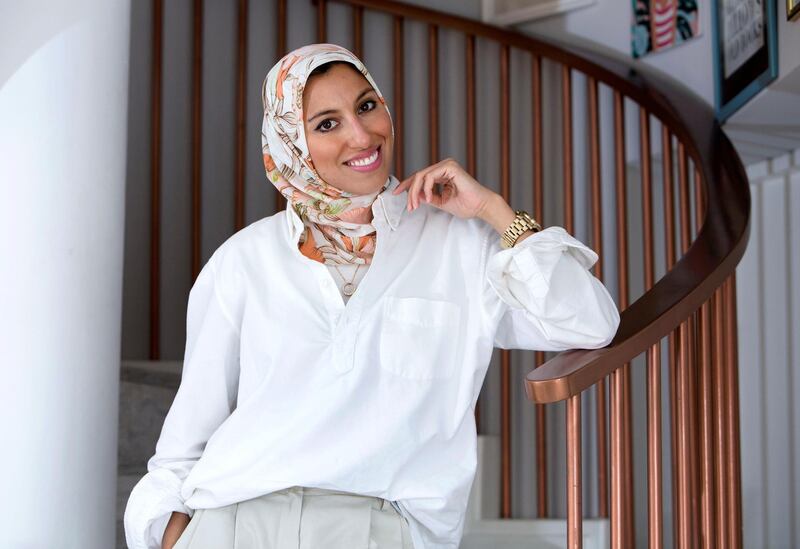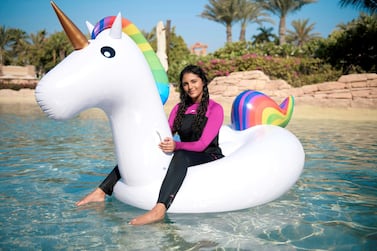In a small factory in Ajman, stacks of salmon-hued scarves are lined up for a final quality control check before being packaged and shipped to a warehouse in Texas. Here, they'll await online orders from the cult American-Muslim following Haute Hijab has attracted over the past nine years.
Scarves may seem too simple a product to build an entire brand around, but that's what Melanie Elturk has done with Haute Hijab, now the leading hijab brand in the United States. Elturk is both the founder and face of the label, which offers a wide range of chiffon, viscose, silk, georgette and jersey scarves, along with breathable "underscarves", which are intended to be worn underneath fashionable scarves. The scarves retail from Dh75 for jersey and chiffon, while a pure silk one costs Dh240.
"About 90 per cent of our orders come from the US and after that from other western countries like Canada, the UK and Australia, and then outside of that we have pockets in the Middle East and South-east Asia, but we've focused on being an American brand," says Elturk, who was as a lawyer before turning to fashion full time, and worked in Dubai for four years before relocating to New York.
While the US may be the business's base, the UAE is its second home – the majority of Haute Hijab's printed chiffon fabrics are sourced here, and they are designed in Ajman.
After a whirlwind trip to the Maldives to celebrate her 10th wedding anniversary with her husband – Haute Hijab's chief operations officer – Elturk recently touched down in Dubai for some fabric shopping, production checks and meetings with investors. She wears shades of white and khaki when we meet, paired with a white chiffon Haute Hijab scarf with a tropical floral print. She tells me the print was sourced locally, from deadstock fabrics. Sustainability, after all, is deeply ingrained in the brand's ethos, though Elturk isn't keen on discussing it in the context of a trend.
"It's hard to talk about this because I don't like to use it as a buzzword, since it's so part and parcel of our values as Muslims that it should be a given with any Muslim-owned company," she says. "This is a constant topic that we're working towards because we want to be part of the solution and not the problem. We're custodians of this Earth and we're going to have to answer for everything we did here.
"When it comes to labour, wages, fair trade, sustainability, all those things are Islamic principles that we should all be adhering to," she adds. The printed chiffon that Elturk sources for Haute Hijab is unwanted, leftover fabric from larger brands and suppliers that would otherwise be thrown away. "That's part of making sure this cycle continues, rather than contributing to all the waste," she says.
Delving further into the idea of eco-friendly textiles, Elturk recently hired a director of design and innovation who is an expert in the field of sustainability. "Something that she's starting to do is look at our everyday products to see how we can replace these with sustainable materials, like rose petals, mushrooms and coffee grounds, rather than creating new fabric out of synthetic materials," Elturk says.
Haute Hijab may be a fashion brand, but its ideology is driven by a deep-rooted sense of faith, and by Elturk's ambitions to serve Muslim women in deeper ways than by providing them with stylish headwear. "I love fashion, but I would not have sustained or been along for this journey this long if it wasn't for the overarching goal of empowering our community," she says. "What I was always trying to do was elevate and empower a woman to make her comfortable and confident in her hijab – and to do that, you have to cultivate a community and then give her resources and inspiration."
Haute Hijab started with a blog, which Elturk and other contributors maintain to this day. Current popular posts on the site cover topics such as choosing the right hijab colour for your skin tone, children's books that will make young people feel proud to be Muslim and problems with racism within the community. Other stories discuss helping the families of converts to understand Islam, the challenges of single motherhood and a call for private holiday resorts where hijab-wearing women won't need to cover up.
Subscribers to the Haute Hijab newsletter receive weekly links to these blog posts, in addition to news about the latest products. "To [build a community], you have to have these different channels. The blog was one of them, YouTube was one and the email newsletter was definitely one, because it was always more than just a product," says Elturk.
While the American market is Haute Hijab's main consumer base, Elturk has plans to expand internationally once she has secured a round of funding, to "improve the hijab experience" for women in the Middle East. "We'd like to open a fulfilment centre here to cater to this market, and to give local women a better solution for the shayla that often comes with their abayas, and slips off," she says. She's also working on launching athletic scarves – a sector that has become increasingly popular since Nike launched its sports hijab in 2017. Slated to be released in the second quarter of 2020, the three designs from Haute Hijab will serve a variety of athletic requirements. "Some girls need something that will not budge, even if they're upside down; others want something that's more athleisure, like for yoga," says the entrepreneur.
Elturk's hard work and motto – to make the hijab mainstream – has paid off over the past decade; in August, Haute Hijab even appeared in video advertisements in New York's Times Square. But Elturk says one of her proudest moments thus far was when The Gap enlisted Haute Hijab to provide headscarves for a campaign about diversity and inclusivity two years ago. "It doesn't get more mainstream than The Gap," she says. Beauty brand Glossier also used Haute Hijab designs in a campaign earlier this year.
Modest fashion has steadily infiltrated the mainstream over the past half-decade, and while some Muslim brands may resent that hijabs are being commodified by big labels from non-Muslim majority countries, potentially drawing consumers away from start-up home-grown Muslim brands, Elturk welcomes the arrival of the headscarf in the mainstream industry.
"I think the impact of mainstream brands coming into the hijab space is incredible because it validates and acknowledges the power of our consumer base," she says. "There's this incredible group of women who need to be heard and catered to, so to see mainstream brands coming into this space is an affirmation of all this work that we've been doing."











